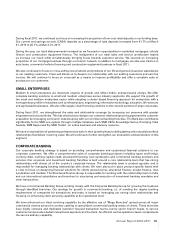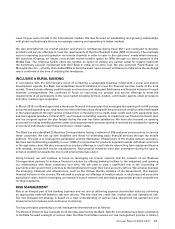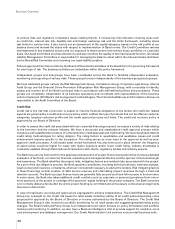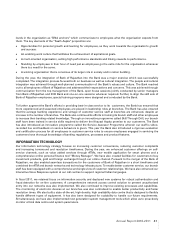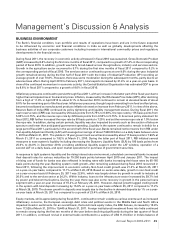ICICI Bank 2011 Annual Report Download - page 43
Download and view the complete annual report
Please find page 43 of the 2011 ICICI Bank annual report below. You can navigate through the pages in the report by either clicking on the pages listed below, or by using the keyword search tool below to find specific information within the annual report.
levels in the organization as “DNA anchors” which communicate to employees what the organisation expects from
them. The key elements of the “Saath Aapka” proposition are:
•Opportunities for personal growth and learning for employees, as they work towards the organisation’s growth
and success.
•An enabling work culture that facilitates the achievement of aspirational goals.
•A merit-oriented organisation, setting high performance standards and linking rewards to performance.
•Standing by employees in their hour of need just as employees go the extra mile for the organisation whenever
there is a need for the same.
•A winning organisation that is conscious of its larger role in society and in nation building.
During the year, the integration of Bank of Rajasthan into the Bank was a major exercise which was successfully
completed. The integration process focused both on business as well as cultural integration. The people and cultural
integration was achieved through well-planned communication of the Bank’s values and culture. The Bank reached
out to all employees of Bank of Rajasthan and addressed their expectations and concerns. This was achieved through
communication from the top management of the Bank, open house sessions jointly conducted by senior managers
from Bank of Rajasthan and ICICI Bank and one-on-one sessions wherever required. Further, to align the skill sets of
Bank of Rajasthan employees, special training programs were designed and conducted by the Bank.
To further augment the Bank’s efforts in providing best-in-class service to its customers, the Bank has ensured that
more experienced and seasoned employees are placed in leadership roles at branches. The Bank has also ensured
that the average banking experience and vintage of customer service staff at branches are enhanced, despite an
increase in the number of branches. The Bank also continued its efforts in training its branch staff and other employees
to increase their banking related knowledge. Through an innovative programme called Skill Through Drill, our branch
staff have been trained in service skills required to deliver the Khayaal Aapka promise to our customers. The Bank
has also introduced an innovative programme called the Service Assessor Programme wherein our staff is video-
recorded live and feedback on service behaviors is given. This year the Bank also introduced a rigorous evaluation
and certification process for all employees in customer service roles to ensure employees engaged in servicing the
customers have thorough knowledge of banking regulations, processes and product features.
INFORMATION TECHNOLOGY
Our information technology strategy focuses on increasing customer convenience, reducing customer complaints
and increasing turnaround and resolution timeframes. During the year, we enhanced customer offerings on self-
service channels, such as value added services through ATMs, new mobile application for smart phones and a
comprehensive online personal finance tool ”Money Manager”. We have also created facilities for customers to buy
investment products, gold and foreign exchange through our online channel. Pursuant to the merger of the Bank of
Rajasthan, we also enabled seamless transactions for the customers of Bank of Rajasthan in a short timeframe and
combined the ATM and branch networks and technology infrastructure. To enable better customer service, our branch
staff has been equipped with a comprehensive and single view of customer relationships. We have also enhanced our
Interactive Voice Response system at our call centres to support regional Indian languages.
In fiscal 2011, we retained focus on information security and deployed new systems for robust authentication and
fraud detection for on-line customers. A comprehensive network access control solution to prevent unauthorised
entry into our networks was also implemented. We also continued to improve existing processes and capabilities.
The monitoring of electronic devices at our branches was also centralised to enable better productivity and faster
resolution times. We also built a state-of-the-art, high density, high availability data centre that is designed to flexibly
handle different types of equipment. It has also been designed for scalability to handle our future requirements.
Simultaneously, we have also implemented next generation system management tools which allow us to proactively
monitor critical data centre and system parameters.
Annual Report 2010-2011 41






